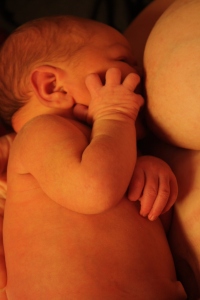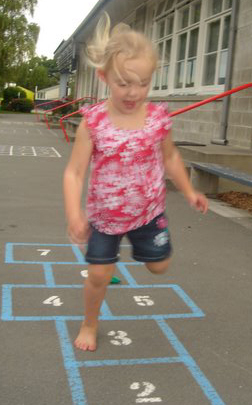REPOST ON A TOPIC I AM PASSIONATE ABOUT
About the Author
Angela Hanscom is a pediatric occupational therapist and the founder of TimberNook, which focuses on nature-centered developmental programming in New England. Angela holds a master’s degree in occupational therapy and an undergraduate degree in Kinesiology (the study of movement) with a concentration in health fitness. She specializes in vestibular (balance) treatment and sensory integration. She is also the author of the upcoming nonfiction book, Balanced & Barefoot, which discusses the effects of restricted movement and lack of outdoor playtime on overall sensory development in children.
NATURE IS THE ULTIMATE SENSORY EXPERIENCE: A Pediatric Occupational Therapist Makes the Case for Nature Therapy
When I tell people I’m a pediatric occupational therapist and that I run nature programming, a look of confusion often crosses their face. “Huh?” they say. Or, “You’re a special needs camp?” Or, “I don’t get it. You’re going to do occupational therapy with our children?”
From the beginning, I quickly realized that the concept of TimberNook is “out-of-the-box” thinking for many people. Some don’t get it at first. The concept is totally foreign to them. Typically, when people think of occupational therapy, they automatically think of children with special needs. I’ve used my skills as an occupational therapist in an unconventional manner. I view nature as the ultimate sensory experience for all children and a necessary form of prevention for sensory dysfunction.
 What most people don’t realize is that pediatric occupational therapists are in a unique position to do something about a very real problem.
What most people don’t realize is that pediatric occupational therapists are in a unique position to do something about a very real problem.
More and more children are presenting with sensory issues these days. They are not moving like they did in years past. It is rare to find children rolling down hills, spinning in circles just for fun, or climbing trees at great heights. In fact, our society often discourages this type of play due to liability issues and fear of falls.
The more we restrict children’s movement and separate children from nature, the more sensory disorganization we see. In fact, according to many teachers, children are frequently falling out of their seats in school, running into walls, tripping over their own feet, and unable to pay attention. School administrators are complaining that kids are getting more aggressive on the playgrounds and “can’t seem to keep their hands off each other” during recess. Teachers are looking for answers.
Pediatric occupational therapists can help. We have the neurological background to explain why restricted movement causes behavior problems in children; why fidgeting is becoming more prevalent than ever before; and the underlying reasons why kids are hitting with more force during a game of tag.
Pediatric occupational therapists can also use their unique understanding of child development to educate others on the therapeutic qualities of nature. For instance, they can explain how listening to bird sounds in nature helps to improve children’s spatial awareness, why spinning in circles establishes a strong balance system, and walking barefoot integrates reflexes that prevent further complications such as toe-walking.
Traditionally, pediatric occupational therapists are found inside schools or indoor clinics. We’ve ventured out to start using animals and gardening for therapy in more recent years. However, I have to wonder…what if more occupational therapists started venturing out even further? What if they used giant mud puddles to get children to explore their senses more fully? What if they went deep into the woods to inspire children to think openly and creatively, while building forts and dens of their own design? What would occupational therapy look like then?
I believe occupational therapists have great potential to use the sensory benefits of play outdoors to help children integrate their senses in the most natural of ways.
Using the Outdoors for Occupational Therapy
Here are some wonderful ways therapists and others can step back and start to see play outdoors as therapeutic in design:
- Climbing trees. In a clinic setting, we traditionally have kids use a plastic climbing wall to work on full-body strengthening and coordination. What if we started letting kids climb trees outside for therapy? This is a little more challenging since trees are not color-coded. Children will need to use their problem-solving skills in order to scale the tree, testing branches as they go to make sure they are safe and sturdy. They would learn safety skills and the tree offers a nice tactile and natural touch experience as they hold onto the tree limbs during the climb.
- Playing in a mud puddle. Occupational therapists often let children play in sensory bins that are filled with colorful rice, beans, and sand. In order to fully maximize a child’s sensory experience and to make it even
 more meaningful, what if we allowed children to play in mud puddles during treatment sessions? Our mud puddles here at TimberNook headquarters are so huge that they also have real frogs and frog eggs in them. The kids have to maneuver through the mud, using their balance, visual scanning skills, and engaging their tactile (touch) senses as they search for a frog.
more meaningful, what if we allowed children to play in mud puddles during treatment sessions? Our mud puddles here at TimberNook headquarters are so huge that they also have real frogs and frog eggs in them. The kids have to maneuver through the mud, using their balance, visual scanning skills, and engaging their tactile (touch) senses as they search for a frog. - Walking barefoot on a log. In the clinic, we often have children go barefoot on plastic balance beams, which have been engineered to be “sensory” with little plastic bumps. If we take children outside, we could let them go barefoot on fallen trees, enhancing their sensory experience on a multitude of different levels. Not only would they be experiencing different textures, but they would feel the sensations of moist versus dry, crunchy versus soft, noisy versus quiet, and changes in temperature.
- Hooking up therapy swings outdoors.Therapists are SO lucky when it comes to swings! We have just about every type of swing imaginable–all for a different purpose. If we brought them outdoors, we would only add to the sensory experience for children. Now they are exposed to bird sounds, the wind on their face, and the shadows playing across the ground as they are swinging. By taking swings outside, we engage all of their senses — not just the vestibular (balance) sense.
- Building forts. In clinics, it is very common and fun to have children design their own obstacle courses. This helps them with problem solving, creativity, and planning. If we took this outside, what might it look like? Children love creating forts of their own design, using everything from sticks and bricks to fabric and Plexiglas. They are still working on the same skills – only they are exposed to more sensory input, while igniting their imaginations at the same time.
Nature truly is the ultimate sensory experience and the perfect medium for occupational therapists to utilize, both for prevention and treatment methods. It is time we step beyond the confining walls of buildings, take our therapy swings outdoors for fresh air, and use the occupation of play outdoors to enrich children’s lives.
Additional Reading & Resources
WHY I PRESCRIBE NATURE – by Robert Zarr, M.D.
VITAMIN “N” and the American Academy of Pediatrics – by Mary Brown, MD
THE WHOLE CHILD: A Pediatrician Recommends the Nature Prescription – by Larry Rosen, MD
GROW OUTSIDE! – Richard Louv’s Keynote Address to the American Academy of Pediatrics


